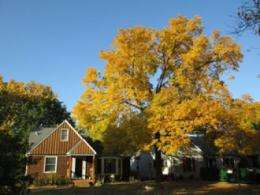Housing sales data used to estimate value of urban natural resources

Trees, water and lawn clearly matter to urban dwellers. For city planners balancing green space with other demands, the question has been just how much green space matters to residents.
Working with lead author Heather Sander of the University of Iowa, economist Robert Haight of the U.S. Forest Service's Northern Research Station estimated how much home buyers are willing to pay for more scenic vistas, better access to outdoor recreation, and greater neighborhood tree cover. Their study, "Estimating the economic value of cultural ecosystem services in an urbanizing area using hedonic pricing," was recently published in the Journal of Environmental Management and is available on-line at: http://nrs.fs.fed.us/pubs/42210
"We have sophisticated ways of measuring many aspects of the services trees provide, such as how much they save homeowners in heating and cooling costs, but people also value natural resources in less tangible ways that are much harder to quantify," said Michael T. Rains, Director of the Forest Service's Northern Research Station. "This study gives cities a tool to elicit another portion of the value of urban natural resources, and knowing these values will enhance regional land use policies."
Estimating the economic value of changes in services associated with neighborhood trees is tricky because those services do not have well-defined markets. Instead, economists use non-market valuation methods, among them hedonic pricing, which estimates the value of an environmental service based on the sales price of a related marketed good, such as residential property. In this case, a home's sale price depends on its location, physical characteristics, and environmental amenities. By estimating the relationship between home sale price and these attributes, Sander and Haight could then determine buyers' willingness to pay for changes in the environmental attributes.
Sander and Haight used data from 5,094 home sales that occurred in Dakota County in 2005 to evaluate how much people were willing to pay for non-material benefits that humans obtain from ecosystems such as increased aesthetic quality, access to outdoor recreation, and neighborhood tree cover. The findings are not surprising – people are willing to pay more for better views of water and lawn, a higher percentage of tree cover, and better access to outdoor recreation areas.
For example, Dakota County home buyers were willing to pay $200-500 more per 10 percent increase in tree cover in their surrounding neighborhood. That willingness to pay represents an important portion of the economic value of services associated with urban trees: the portion that contributes directly to tax bases.
Putting a price on people's value of natural resources is useful in evaluating land-use policy, according to Sander, an Assistant Professor in the University of Iowa's Department of Geography. "Urban planning has to take into account a variety of competing interests," Sander said. "Our intent was to develop a method for using easily accessible information to better understand homeowners' willingness to pay for cultural ecosystem services. This could improve the ability of urban planners to consider these competing interests."
The values expressed in Dakota County homes sales do not necessarily transfer to other communities, according to Haight. "Communities have unique characteristics that can affect how residents value natural resources. While homeowners in Dakota County may generally speak for the Twin Cities, they certainly do not reflect the values of people in Duluth or Fargo."
Journal information: Journal of Environmental Management
Provided by USDA Forest Service
















